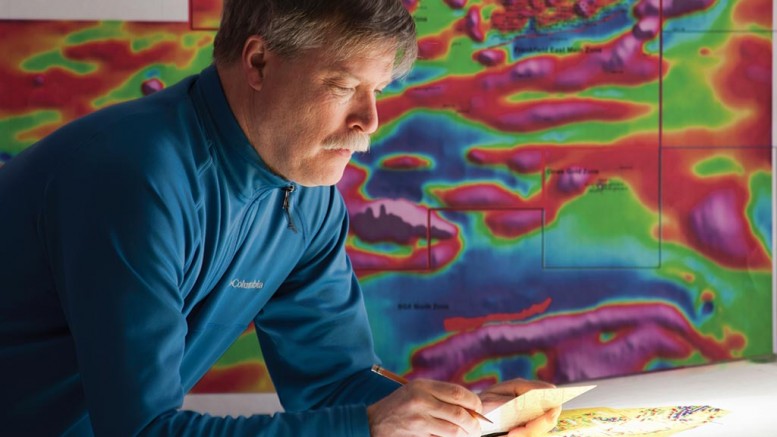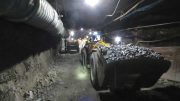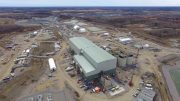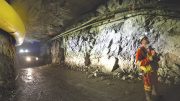Ontario’s long and prosperous mining history has allowed more than a few juniors to hit the filing cabinets to dust off old mining projects and try to revive them. Here’s a look at seven juniors advancing projects old and new across the province.
CADILLAC VENTURES
Copper isn’t the first metal to come to mind when most people think of Ontario, but that’s exactly what Cadillac Ventures’ (TSXV: CDC; US-OTC: CADIF) target is at its wholly owned, advanced Thierry project, 15 km west of Pickle Lake, Ontario.
Belgium’s Union Minière operated an open-pit and underground copper mine at Thierry from 1976 to 1982.
The property later saw exploration programs by various owners — including Iberian Minerals, Richview Resources and Cadillac — which together spent more than $31 million between 2002 and 2015 on drilling, surface programs and metallurgical studies. (Cadillac’s president and CEO Norman Brewster was formerly an interim CEO of Iberian Minerals.)

A driller on a rig at Cadillac Ventures’ Thierry copper project in northwestern Ontario’s Pickle Lake region. Credit: Cadillac Ventures.
The property’s main deposits — the Thierry mine and K1-1 — remain open at depth, and Cadillac says the 3 km distance between them is “largely untested.”
The last National Instrument 43-101 compliant resource estimate was calculated in 2012, and it tallied 8.8 million measured and indicated tonnes grading 1.66% copper for 322 million contained lb. copper, plus 14.9 million inferred tonnes at 1.64% copper for 538 million contained lb. copper. Also present are low-grade, by-product nickel, gold, palladium silver and platinum.
The K1-1 deposit has an open-pittable, inferred resource of 53.6 million tonnes at 0.38% copper and 0.10% nickel for 449 million contained lb. copper, over a 1.2 km strike length.
A preliminary economic assessment of a revived, 15,000-tonne-per-day operation at Thierry foresees a $500-million capital cost, 19% pre-tax internal rate of return and $380-million net present value, using a 6% discount rate.
In July 2016, Cadillac entered an option agreement with an arm’s length private Ontario company named Northern Fox Resources, whereby Northern Fox can earn a 70% interest in the Thierry property for $100,000 in cash, 6 million Northern Fox shares and $13.9 million in work on the project.
In September, Cadillac raised $600,000 via a warrant exercise, resulting in 12 million shares issued at a nickel apiece.
GOWEST GOLD
Toronto-based Gowest Gold (TSXV: GWA) is focused on “building Timmins’ next gold mine” at its Bradshaw deposit north of Timmins, Ontario.
Bradshaw has an indicated resource of 2.1 million tonnes grading 6.19 grams per tonne gold for 422,000 contained oz. gold, plus 3.6 million inferred tonnes grading 6.47 grams for another 755,000 contained oz. gold.

A sign at Gowest Gold’s North Timmins Gold project in Timmins, Ontario. Credit: Gowest Gold.
The company reported in August that ramp development had exceeded 350 metres and was “closing in” on the first ore zone; two shifts were operating at the mine site around the clock, seven days a week; an ore sorter is expected to arrive at the site by the end of September; the company will soon take a 30,000-tonne bulk sample from the newly accessed ore zone; and a water-treatment plant and ponds are to be commissioned by the end of September.
Gowest says it is working with Northern Sun Mining (acquired by privately held Regal Silver investments in April 2016) to close a transaction to operate and co-own the Redstone mill in Timmins, where Gowest expects to send its first ore from Bradshaw in the fourth quarter, followed by commercial production starting in late 2018.
In December 2016, Gowest entered into a gold-sales agreement with PGB Timmins Holdings LP — an investment vehicle controlled by Pandion Mine Finance LP — totalling up to US$17.6 million in four tranches over 12 months, as partial consideration for buying up to 65,805 oz. gold produced from Bradshaw and delivered to PGB.
OREFINDERS RESOURCES
Led by CEO Stephen Stewart — who played a key role in launching Young Mining Professionals’ Toronto branch a few years ago — Orefinders Resources (TSXV: ORX; US-OTC: ORFDF) is focused on developing its Mirado gold property in Ontario’s Kirkland Lake gold camp.
The Mirado property has three former producing mines, including the South Zone, where Orefinders is completing a preliminary economic assessment to put an open-pit mine back into production.
By mid-year, Orefinders had already sold 1,414 oz. gold from a bulk sample taken from old stockpiles at the Mirado mine, with the bulk sample grading 2 grams gold per tonne.

Disseminated gold mineralization associated with pyrite at Mirado. Credit: Orefinders Resources.
Orefinders describes the Mirado property as divided by the Mirado fault, with two mineralization styles on each side: high-grade pyritic, stringer-stockwork in the South Zone, where open-pit mining took place in the 1980s; and gold-rich volcanogenic, massive sulphide mineralization in the North Zone, where underground mining took place in the 1930s.
Orefinders says “all infrastructure is in place to resume a mining operation,” and that mining could begin in the near-term by excess milling capacity elsewhere in the Kirkland Lake region.
In June, veteran geologist Charles Beaudry joined Orefinders as vice-president of exploration.
Orefinders is completing an updated resource calculation at Mirado and preliminary economic assessment, with an eye towards restarting the open-pit mine using toll milling.
PROSPER GOLD
Vancouver-based Prosper Gold (TSXV: PGX; US-OTC: PRGCF) is headed up by president and CEO Peter Bernier and vice-president of exploration Dirk Tempelman-Kluit, who were behind Richfield Ventures and its large Blackwater gold deposit in British Columbia. Richfield was acquired by New Gold in 2011 for $500 million.
Prosper’s primary asset is its high-grade Ashley gold project in Ontario’s Matachewan area, where the company has an option to acquire a 100% interest in the Ashley mine property and a 90% interest in the related Wydee and Matachewan claims.

“The Ashley vein is like somebody’s arm. Somebody has found the arm, but where’s the body? We’re looking for the body.”
Dirk Tempelman-Kluit
Vice-president of exploration, Prosper Gold
The Ashley mine was the site of a mining operation from 1932 to 1937 that produced 50,099 oz. gold from 143,000 tonnes ore (10.97 grams gold per tonne) from the main Ashley vein, which strikes north, dips west at 30 to 50 degrees, and has been followed underground for 600 metres.
Prosper says historical surface exploration documents seven gold-bearing veins on the property, including the Garvey vein, 1.3 km northwest of Ashley, which produced a 24-tonne bulk sample yielding 29.5 grams gold per tonne.
Since April, Prosper has been carrying out a 10,000-metre drilling campaign at multiple targets across the property, with results expected soon.
SAGE GOLD
Toronto-based, Nigel Lees-led Sage Gold (TSXV: SGX; US-OTC: SGGDF) is another junior active in Ontario’s Timmins camp. It is advancing its Clavos gold project, where an initial mill run of stockpiled material should be completed in October.
The project is permitted to run up to 700 tonnes per day, and Sage has negotiated a life-of-mine toll-milling contract with the Stock mill.
Sage says dewatering and rehabilitation of the Clavos workings are near complete, which will allow for high-grade exploration drilling to start from underground, even with extensive definition drilling ongoing. Stopes are already being developed and mineralized material is getting stockpiled.

The entrance culvert at Sage Gold’s past-producing Clavos gold project in northern Ontario’s Timmins camp. Credit: Sage Gold.
Sage looks to increase resources and near-term production potential at Clavos, and consolidate other advanced gold deposits in the Timmins area.
The firm could produce 100,000 oz. gold from all its assets within three years.
A preliminary economic assessment carried out in 2013 foresaw Clavos costing only $8 million in initial capital expenses to build a mine that would produce 145,448 oz. gold over a seven-year mine life, generating a $13-million net present value at an 8% discount rate and a 47% internal rate of return, after taxes.
ROCK TECH LITHIUM
Vancouver-based junior Rock Tech Lithium (TSXV: RCK; US-OTC: RCKTF) is exploring spodumene-bearing pegmatites of the Georgia Lake area, 145 km northeast of Thunder Bay, Ont., where lithium was first found in 1955.
In October 2012, Rock Tech calculated a National Instrument 43-101 compliant reource estimate for the property of 3.19 million indicated tonnes grading 1.10% Li2O and 6.31 million inferred tonnes grading 1% Li2O.
The company says metallurgical tests of the pegmatites show: concentration of high-grade spodumene from high and low-grade mineralized material; a 76% recovery rate, using heavy liquid separation; and 81% using flotation.
Its hydrometallurgical testing shows lithium carbonate produced with a 99.96% purity without any process optimization, and 99.98% with bicarbonate scrubbing.
Rock Tech has signed a memorandum of understanding with three First Nations near the project that the company says creates a foundation for benefits and impact agreements.
The company spent mid-2017 on the ground at the property carrying out a sampling and exploration program to generate targets for follow-up trenching and drilling. The work found two pegmatites next to the property’s Nama Creek main resource zone. TNM






Be the first to comment on "Ontario Snapshot: Six juniors advancing gold, copper and lithium projects"